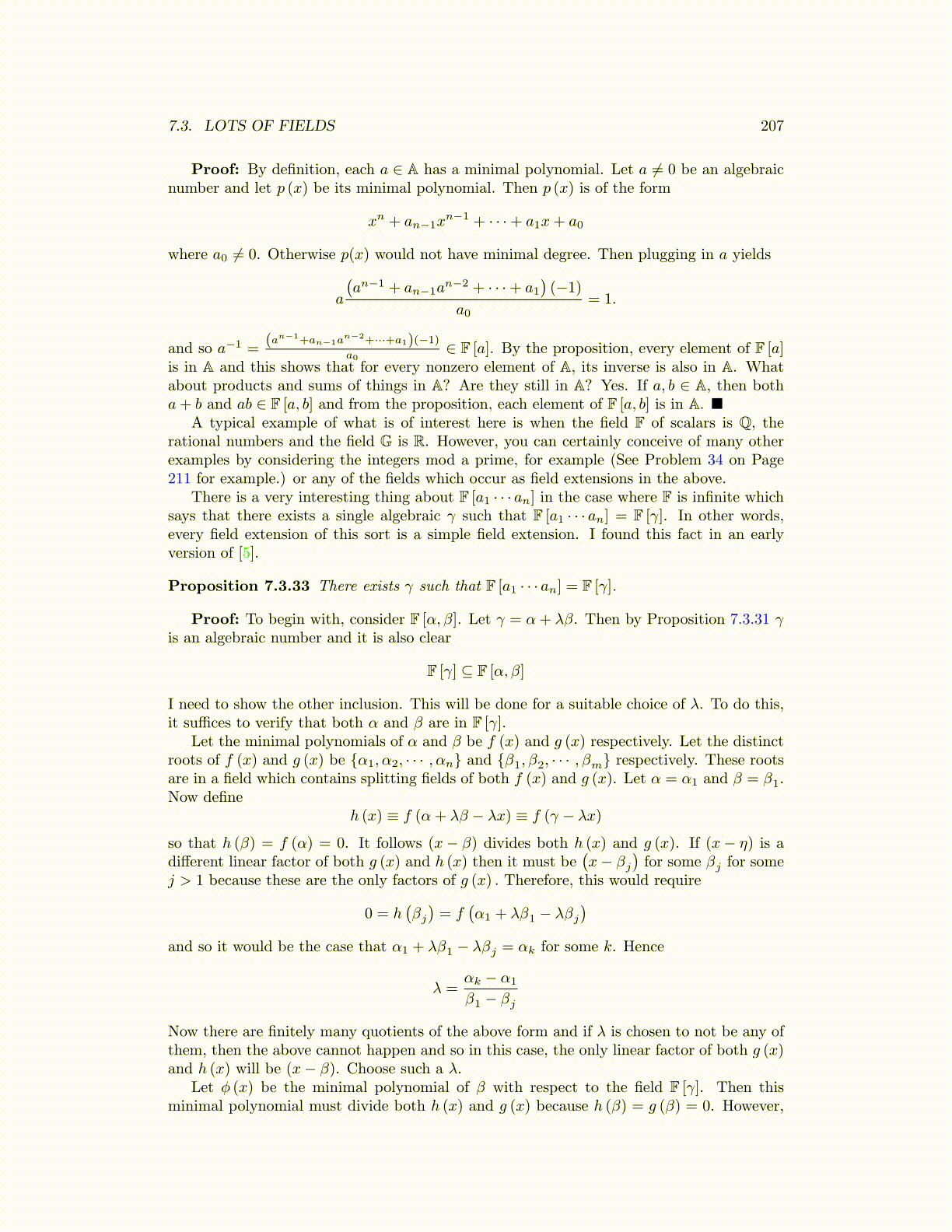
7.3. LOTS OF FIELDS 207
Proof: By definition, each a ∈ A has a minimal polynomial. Let a ̸= 0 be an algebraicnumber and let p (x) be its minimal polynomial. Then p (x) is of the form
xn + an−1xn−1 + · · ·+ a1x+ a0
where a0 ̸= 0. Otherwise p(x) would not have minimal degree. Then plugging in a yields
a
(an−1 + an−1a
n−2 + · · ·+ a1)(−1)
a0= 1.
and so a−1 =(an−1+an−1a
n−2+···+a1)(−1)
a0∈ F [a]. By the proposition, every element of F [a]
is in A and this shows that for every nonzero element of A, its inverse is also in A. Whatabout products and sums of things in A? Are they still in A? Yes. If a, b ∈ A, then botha+ b and ab ∈ F [a, b] and from the proposition, each element of F [a, b] is in A. ■
A typical example of what is of interest here is when the field F of scalars is Q, therational numbers and the field G is R. However, you can certainly conceive of many otherexamples by considering the integers mod a prime, for example (See Problem 34 on Page211 for example.) or any of the fields which occur as field extensions in the above.
There is a very interesting thing about F [a1 · · · an] in the case where F is infinite whichsays that there exists a single algebraic γ such that F [a1 · · · an] = F [γ]. In other words,every field extension of this sort is a simple field extension. I found this fact in an earlyversion of [5].
Proposition 7.3.33 There exists γ such that F [a1 · · · an] = F [γ].
Proof: To begin with, consider F [α, β]. Let γ = α+ λβ. Then by Proposition 7.3.31 γis an algebraic number and it is also clear
F [γ] ⊆ F [α, β]
I need to show the other inclusion. This will be done for a suitable choice of λ. To do this,it suffices to verify that both α and β are in F [γ].
Let the minimal polynomials of α and β be f (x) and g (x) respectively. Let the distinctroots of f (x) and g (x) be {α1, α2, · · · , αn} and {β1, β2, · · · , βm} respectively. These rootsare in a field which contains splitting fields of both f (x) and g (x). Let α = α1 and β = β1.Now define
h (x) ≡ f (α+ λβ − λx) ≡ f (γ − λx)
so that h (β) = f (α) = 0. It follows (x− β) divides both h (x) and g (x). If (x− η) is adifferent linear factor of both g (x) and h (x) then it must be
(x− βj
)for some βj for some
j > 1 because these are the only factors of g (x) . Therefore, this would require
0 = h(βj
)= f
(α1 + λβ1 − λβj
)and so it would be the case that α1 + λβ1 − λβj = αk for some k. Hence
λ =αk − α1
β1 − βj
Now there are finitely many quotients of the above form and if λ is chosen to not be any ofthem, then the above cannot happen and so in this case, the only linear factor of both g (x)and h (x) will be (x− β). Choose such a λ.
Let ϕ (x) be the minimal polynomial of β with respect to the field F [γ]. Then thisminimal polynomial must divide both h (x) and g (x) because h (β) = g (β) = 0. However,